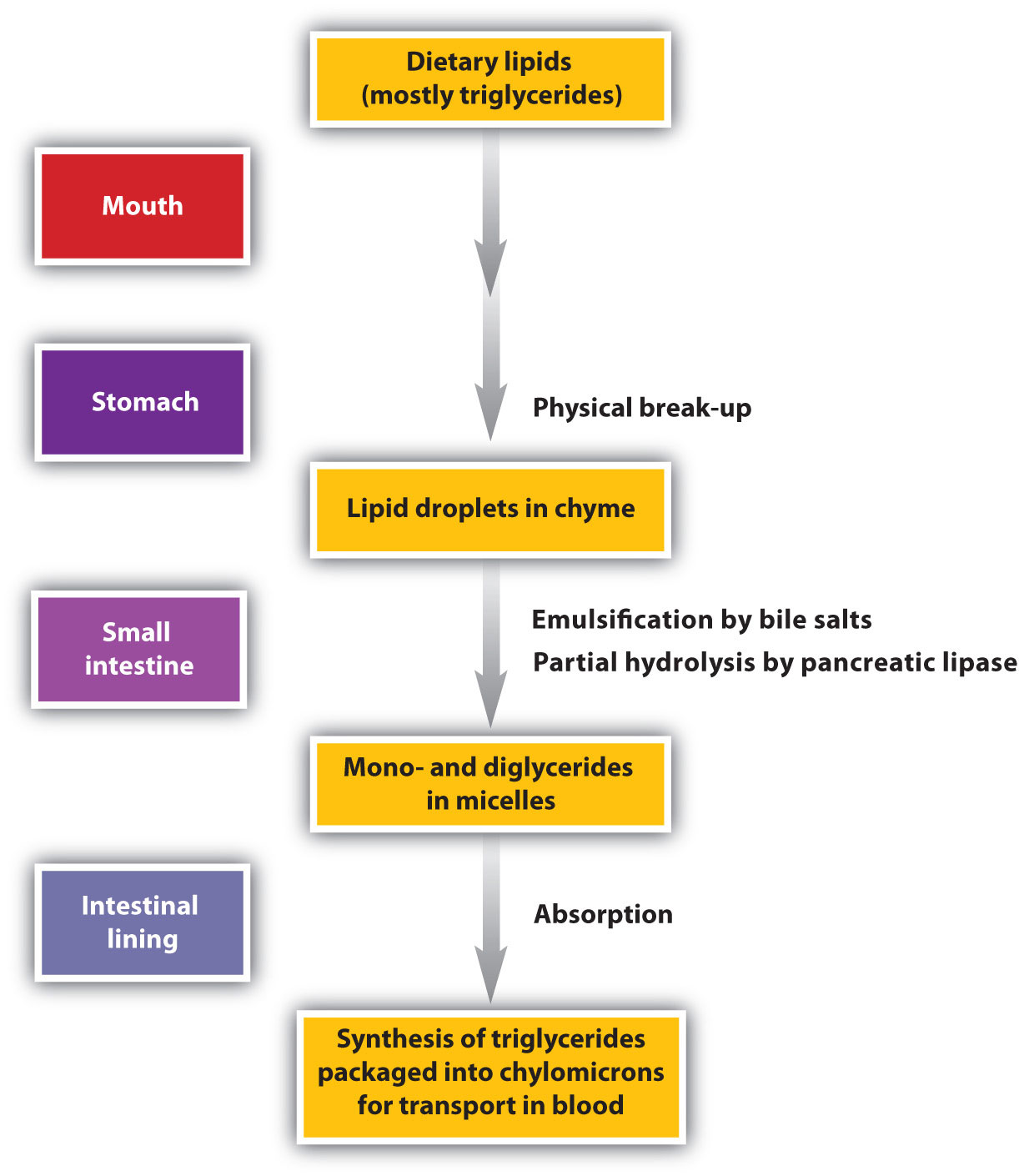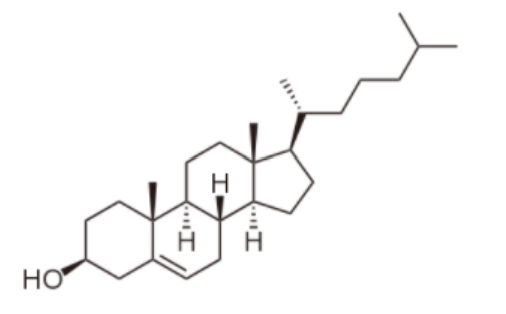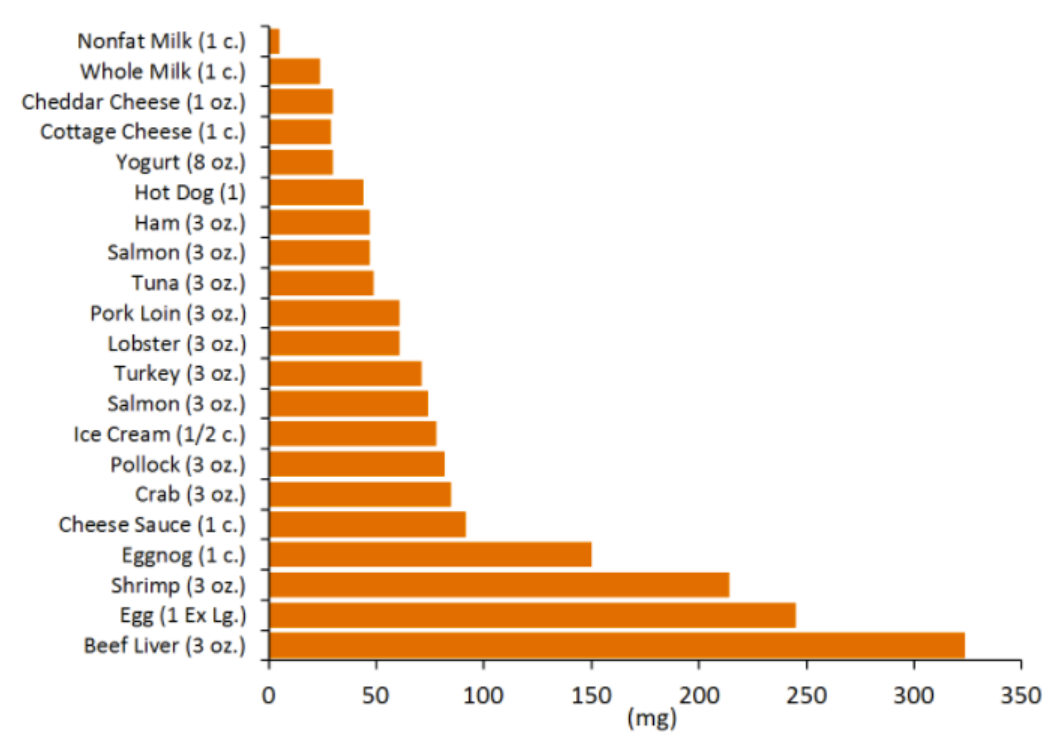9.1: Stage I of Lipid catabolism
- Page ID
- 234040
Learning Objectives
- Describe the digestion of lipids.
- Know the properties and functions of the different types of lipoproteins.
- Know the sources and function of common dietary lipids.
Digestion of Lipids
Lipid digestion begins in the upper portion of the small intestine (Figure \(\PageIndex{1}\)). A hormone secreted in this region stimulates the gallbladder to discharge bile into the duodenum. The principal constituents of bile are the bile salts, which emulsify large, water-insoluble lipid droplets, disrupting some of the hydrophobic interactions holding the lipid molecules together and suspending the resulting smaller globules (micelles) in the aqueous digestive medium. These changes greatly increase the surface area of the lipid particles, allowing for more intimate contact with the lipases and thus rapid digestion of the fats. Another hormone promotes the secretion of pancreatic juice, which contains these enzymes.

Figure \(\PageIndex{1}\) The principal events and sites of lipid (primarily triglyceride) digestion.
The lipases in pancreatic juice catalyze the digestion of triglycerides first to diglycerides and then to 2‑monoglycerides and fatty acids:

Phospholipids and cholesterol esters undergo similar hydrolysis in the small intestine, and their component molecules are absorbed through the intestinal lining. The monoglycerides and fatty acids are absorbed by the intestinal lining cells and then they are resynthesized into triglycerides. In order to be transported in the aqueous media of the bloodstream, triglycerides are combined with proteins and cholesterol forming lipoprotein complexes known as chylomicrons.
Fats, Cholesterol, and lipoproteins in the blood
Chylomicrons are are complex combination of fats (phospholipids, triacylglycerol, cholesterol, etc) and proteins (sometimes called apolipoprotein), so another way to refer to chylomicros is lipoproteins. These complexes are necessary to transport the lipids through the blood. Different types of lipoproteins have a different composition and therefore, different density.
Model of a Chylomicron. Image by OpenStax College, CC BY 3.0, via Wikimedia Commons
According tor their density, chylomicrons or liporproteins are classify as high-density lipoproteins (HDL), low-density lipoporteins (LDL), and very low-density lipoproteins (VLDL). The table shows the properties of each.
The table below also shows the difference in density, diameter, and composition of different lipoproteins. Notice that as diameter decreases, density increases.
| Lipoprotein | Density (g/dL) | Diameter (nm) | % protein | % cholesterol | % phospholipid | % triacylglycerol | Purpose |
|---|---|---|---|---|---|---|---|
| HDL (high-density lipoproteins) | 1.063-1.21 | 5-12 | 33 | 30 | 29 | 4-8 | It is sometimes called "good" cholesterol because it carries cholesterol from other parts of your body back to your liver. Your liver then removes the cholesterol from your body. |
| LDL (low-density lipoproteins) | 1.019-1.063 | 18-25 | 25 | 56-50 | 21-22 | 8-10 | It is sometimes called "bad" cholesterol because a high LDL level leads to the buildup of plaque in your arteries. |
| VLDL (very low-density lipoproteins) | 0.95-1.006 | 30-80 | 10 | 22 | 18 | 50 | Some people also call VLDL a "bad" cholesterol because it too contributes to the buildup of plaque in your arteries. But VLDL and LDL are different; VLDL mainly carries triglycerides and LDL mainly carries cholesterol. |
You are probably familiar with HDL and LDL being referred to as "good cholesterol" and "bad cholesterol," respectively. This is an oversimplification to help the public interpret their blood lipid values, because cholesterol is cholesterol; it's not good or bad. HDL and LDL both contain cholesterol but there difference is in their composition. The percenge of cholesterol in LDL is much higher What's so bad about LDL? Too much cholesterol in the blood can combine with other substances to form plaque. Plaque sticks to the walls of the arteries. This buildup of plaque is known as atherosclerosis. It can lead to coronary artery disease, wherein the coronary arteries become narrow or even blocked.
HDL is good in that it scavenges cholesterol from other lipoproteins or cells and returns it to the liver.
Cholesterol is only found in foods of animal origin, frequently as a cholesterol esters, meaning that there is a fatty acid attached to the OH group. If consumers were more knowledgeable, intentionally misleading practices, such as labeling a banana “cholesterol free”, would not be as widespread as they currently are today. Although cholesterol has acquired the status of a nutrition "villain", it is a vital component of cell membranes and is used to produce vitamin D, hormones, and bile acids. You can see the similarity between the structures of vitamin D and estradiol, one of the forms of estrogen shown below.

Figure \(\PageIndex{2}\) The carbon ring structure of cholesterol1
We do not need to consume any cholesterol from our diets (not essential) because our bodies have the ability to synthesize the required amounts. The figure below gives you an idea of the cholesterol content of a variety of foods.

Figure \(\PageIndex{4}\) The cholesterol content (mg) of foods4
The most common cause of high cholesterol is an unhealthy lifestyle. This can include:
- Unhealthy eating habits, such as eating lots of bad fats. One type, saturated fat, is found in some meats, dairy products, chocolate, baked goods, and deep-fried and processed foods. Another type, trans fat, is in some fried and processed foods. Eating these fats can raise your LDL (bad) cholesterol.
- Lack of physical activity, with lots of sitting and little exercise. This lowers your HDL (good) cholesterol.
- Smoking, which lowers HDL cholesterol, especially in women. It also raises your LDL cholesterol.
Genetics may also cause people to have high cholesterol. For example, familial hypercholesterolemia (FH) is an inherited form of high cholesterol. Other medical conditions and certain medicines may also cause high cholesterol.
Summary
- Digestion of lipids by lipases in pancreatic juice occurs primarily in the small intestines. The monoglycerides and fatty acids cross the intestinal lining into the bloodstream, where they are resynthesized into triglycerides and transported as chylomicrons. Phospholipids and cholesteryl esters undergo similar hydrolysis in the small intestine, and their component molecules are also absorbed through the intestinal lining.
- Two lipoproteins (composed of a lipid and a protein) of great interest are HDL "good cholesterol transporter" and LDL "bad cholesterol transporter."
Sources
- Wikipedia
- National Institute of Health (NIH) MedlinePlus
- Lipoprotein on Wikipedia. Retrieved Sept. 27, 2020.


